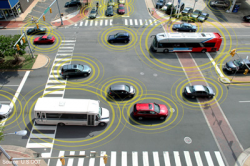— The Department of Transportation has launched a test of 3,000 cars, trucks and buses equipped with “connected” wireless technology to enable vehicles and infrastructure to “talk” to each other in real time.
The real-world road test will determine if the technology can help avoid crashes and improve traffic flow.
The experiment is part of a year-long safety pilot conducted by the University of Michigan’s Transportation Research Institute.
The test vehicles are equipped with vehicle-to-vehicle and vehicle-to-infrastructure devices that will gather data and measure its effectiveness at reducing crashes.
Taking place in the streets of Ann Arbor, Mich., researchers hope to discover if wireless crash-avoidance technology can help a driver avoid intersection accidents, forward collisions, or keep a driver from passing another vehicle at the wrong time.
According to the National Highway Traffic Safety Administration, vehicle-to-vehicle technology could help drivers avoid or reduce the severity of four out of five unimpaired vehicle crashes.
That means if it’s a drunk or impaired driver the technology won’t help much because everything depends of the driver reacting to alerts.
Another problem could be the cost. In earlier research, drivers said they would not even consider paying more than $250 for a bundled package of vehicle-to-vehicle safety features.

